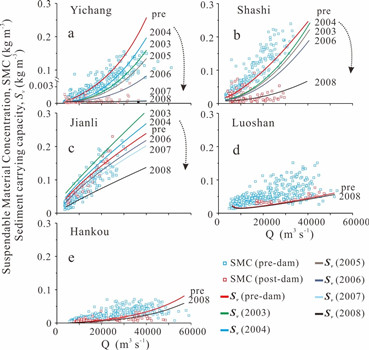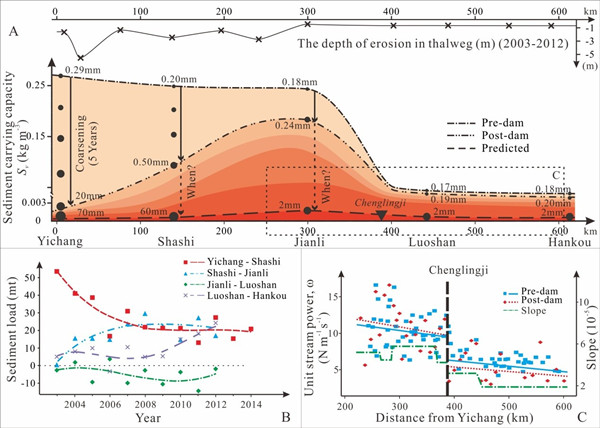三峡坝下的河床冲刷是否会在中游停止?
自然河流系统在受到人类建坝活动的影响下,其水、沙等要素都会发生变化,因此也将打破河流原有的平衡状态,促使河床地貌调整,开始重新适应新的平衡状态。研究河流平衡-不平衡-平衡的动力地貌过程是当前河流地貌学的学科前沿。三峡工程作为世界最大的水利工程,自筹建开始便争议不断,其中三峡坝下游河道冲刷问题,已经成为热议的话题;三峡论证相关研究单位认为三峡引起的坝下河床冲刷将延伸至河口区。
本文以三峡坝下660 km河道(宜昌至汉口)为研究区,通过对悬沙、床沙以及水流挟沙力等水沙动力数据进行分析,我们发现,在三峡封坝后的10年里,长江中游河段由季节性冲淤转变为常年冲刷状态,且这一模式在上荆江地区表现最为明显。河床冲刷会引起床面粒径粗化,形成粗化层,并逐渐降低水流挟沙力,从而达到一个新的平衡状态。目前宜昌站冲刷基本完成(床沙粒径D50由建坝前0.29 mm粗化到20 mm);河床冲刷正在逐渐往下游过渡,沙市、监利正处于冲刷过程中。此外,我们的研究表明,而由于坡降、基岩等因素控制,城陵矶(坝下400 km处)以下河段的单位水流能量和水流挟沙力明显变小,未来几十年三峡大坝引起的河床冲刷有可能在达城陵矶-汉口停止,由此提出早期有关三峡坝下河床冲刷延伸至河口的猜想并不会实现。
Fig. 4. Suspendable material concentration (SMC) and sediment carrying capacity (Sv) pre and post the Three Gorges Dam for five stations sequentially downstream.
Fig. 5. A) Schematic diagram showing downstream changes in sediment-carrying capacity at a discharge of 40,000 m3 s-1 in the middle Yangtze River pre- and post-dam, and the predicted value based on expected coarsening of riverbed sediment. Measured incision amount from 2003 to 2013 is plotted above (CWRC, 2000–2014); B) Annual sediment loads generated in the four reaches of this section of the river from 2003 to 2012/14 (CWRC, 2000–2014). Curve fitting by polynomial; C) Downstream trends of unit stream power from Jianli (S3) to Luoshan (S4) pre- and post-dam and river channel slope through this reach (Data sourced from Wang et al. (2009)).
相关成果已在JOURNAL OF HYDROLOGY上发表,全文见:
-
Journal of Hydrology ,
2017 ,
554
: 24-31


